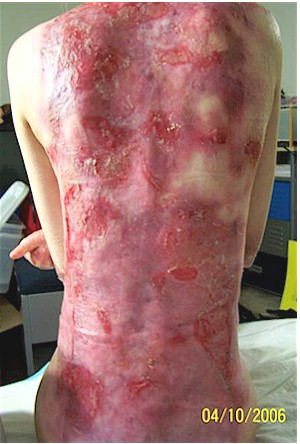Epidermolysis Bullosa - types, symptoms and treatment

The collective term for a group of inherited SKIN disorders that result in blisterlike formations (bullae) on the skin. Severity can range from mild (a few bullae) to debilitating (bullae covering large areas of the body). Dermatologists classify epidermolysis bullosa according to the layer of the skin where the bullae originate.
There are three general types of epidermolysis bullosa:
- Epidermolysis bullosa simplex involves the epidermis, the skin’s outermost layer, and usually results from an autosomal dominance inheritance pattern for the gene that encodes keratin production.
- Junctional epidermolysis bullosa involves the basement membrane, a thin layer of cells that separates the epidermis and the dermis, and usually results from an autosomal recessive inheritance pattern for the gene that encodes protein structures which connect the epidermis and dermis through the basement membrane.
- Dystrophic epidermolysis bullosa involves the basement membrane as well, occurring in either an autosomal dominance or a recessive inheritance pattern for the gene that encodes collagen formation.
In all types, bullae form with friction or irritation to the skin. In the junctional and dystrophic types, this includes the mucous membranes of the gastrointestinal and genitourinary tracts. Healed bullae typically leave scars. The severity of symptoms and disease vary according to the type and, with dystrophic epidermolysis bullosa, the inheritance pattern (dominant or recessive). At present there is no cure for any type of epidermolysis bullosa.
Symptoms of Epidermolysis Bullosa and Diagnostic Path
The bullae of epidermolysis bullosa are uniquely characteristic and typically begin in infancy. The skin is frail and may BLISTER or tear upon touch or contact with clothing and bedding. The bullae of epidermolysis bullosa simplex generally affect only the palms of the hands and soles of the feet. The bullae of other types may affect mucous membranes throughout the body. The repeated blistering and HEALING of junctional and dystrophic types causes scarring and tissue damage that often results in deformities. People who have junctional or dystrophic epidermolysis bullosa may also have defects of the tooth enamel and the NAILS, or be missing fingernails or toenails.
The diagnostic path includes examination of the entire skin surface and mucous tissues with biopsy to determine the level of tissue separation in representative bullae, which distinguishes the general type of epidermolysis bullosa. Molecular examination, including DNA mutation analysis identifies the precise type. CHORIONIC VILLI SAMPLING (CVS) during PREGNANCY (removing a small tissue sample from the edge of the PLACENTA) can identify whether the FETUS has the disorder.
Epidermolysis Bullosa Treatment Options and Outlook
Treatment attempts to minimize or prevent bullae formation, heal bullae that do form, and provide necessary supportive care such as PARENTERAL NUTRITION. Healing mechanisms are often impaired, and ruptured bullae and related tissue damage can leave tissues exposed. Burn therapies such as artificial skin can provide a temporary covering to improve healing. Support groups offer forums for sharing experiences and coping methods.
People who have mild forms of disease may experience few bullae or complications and be able to enjoy fully active lives. More severe forms are debilitating or fatal. It is important though difficult to prevent ruptured bullae from becoming infected. Nutritional deficiencies are common when bullae form along the gastrointestinal mucosa, which may interfere with swallowing (bullae that form in the ESOPHAGUS) or absorption (bullae that form in the SMALL INTESTINE). The risk for squamous cell SKIN CANCER is very high among people who have junctional epidermolysis bullosa, with first appearance often in late ADOLESCENCE. Dermatologists advise frequent skin self-examinations and regular skin examinations by a dermatologist who has clinical experience with epidermolysis bullosa.
Epidermolysis Bullosa Risk Factors and Preventive Measures
Epidermolysis bullosa is a genetic disorder, so the primary risk factor is a family history of the condition. In autosomal recessive INHERITANCE PATTERNS, it is possible for each parent to carry the gene defect yet show no indications of disease or to have a mild form and not realize it. GENETIC TESTING can help families detect the presence of the gene MUTATION, and GENETIC COUNSELING can help couples in making family-planning decisions. Researchers continue to explore GENE THERAPY solutions.
See also BULLA; FAMILY MEDICAL PEDIGREE; GENETIC DISORDERS; HYPERHIDROSIS; MUSCULAR DYSTROPHY; SCAR; SKIN SELF-EXAMINATION; TEETH.
Open discussion on the topic Epidermolysis Bullosa - types, symptoms and treatment
Similar interests
- Nuovi Casino
- Casinos Not On Gamstop
- UK Casinos Not On Gamstop
- Casinos Not On Gamstop
- UK Casinos Not On Gamstop
- Casino Non Aams Italia
- Slot Sites Not On Gamstop
- Meilleur Casino En Ligne
- Non Gamstop Casino Sites UK
- Meilleur Casino En Ligne
- Casino En Ligne France
- Best Non Gamstop Casinos
- Casinos Not On Gamstop
- UK Casino Not On Gamstop
- Casinos Not Signed Up To Gamstop
- Best Slot Sites UK
- Non Gamstop Casino Sites UK
- Online Casinos Nederland
- Online Casinos Nederland
- Casinos Not On Gamstop
- Best New Uk Casinos Not On Gamstop
- Casino Non Aams
- Non Gamstop Casinos UK
- Migliori Siti Casino Non Aams
- Bitcoin Casinos
- Sites De Paris Sportifs Belgique
- Bookmaker Non Aams
- Casino En Ligne